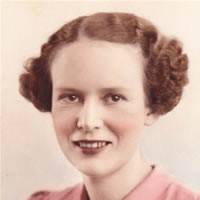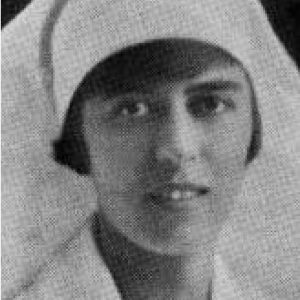Women were overrepresented on overseas missionary service . Overseas missionary service provided opportunities for church women to widen the narrow parameters offered by home, society and Church. In isolated areas where women worked alone there was no alternative but to play leadership roles. However, women often found it difficult to obtain work in the home Church on return from home service.

Mavis Parkinson (1915–1942)
Teacher and martyr.
Click for More
Mavis Parkinson (1915–1942)
Mavis Parkinson felt called to be a missionary and trained as a teacher to be sent to New Guinea. She was killed near Popondetta on the way back to Port Moresby.
The tragic, and yet courageous stories of Mavis Parkinson and May Hayman, and the other ten Anglican missionaries who were killed by the Japanese Army in World War 2 in New Guinea are told with the titles “Faithful unto death” and “The Seed of the Church”. The issue remains controversial: whether they should have evacuated from PNG at the imminent approach of the Japanese Army or the decision they made to stay at their Mission stations. The word “martyr” is appropriate, as in the Christian tradition, because they were faithful to Christ and his Church unto death.
Mavis Parkinson, born in 1915, was very involved in St Paul’s Anglican Church Ipswich from a young child. She was a Sunday School teacher and member of the Girls’ Friendly Society. One of the clergy said of her “I believe she had a vision which gave her inspiration; there was a power in her life”. At age 26 she felt the call to missionary service and was a teacher at the Anglican Mission School at Gona, New Guinea. In 1942 the approach of the Japanese army was imminent and she and her friend/colleague Nurse May Hayman made the decision to remain at their station at Gona. It is here that we capture the elegance of Mavis Parkinson. She writes of her last night at the Mission station, in her last letter “both sister and I had on our pretty long dresses, dinner was a gay meal and our lovely polished table with its pretty mats and beautiful flowers did not fail to call forth the usual compliments”.
However, with the close approach of the Japanese invasion, an arduous escape journey ensued for them through the jungle, in the company of another missionary, and some Allied soldiers. They sheltered for a time in a hut in the jungle, but eventually the two were separated from the group, captured, tortured and executed by Japanese soldiers near Popondetta, their bodies thrown into a nearby grave.
Honour is paid to Mavis Parkinson in a number of Churches in Brisbane Diocese. A large Memorial Cross is in the grounds of St Paul’s Church Ipswich, and a Martyrs’ Chapel is inside the Church. She is honoured in the south transept of the St John’s Cathedral stained glass windows, in a group of modern heroic women.
The New Guinea Martyrs are commemorated on September 2 in the Diocese of Papua New Guinea and the Australian Church.
The New Guinea Martyrs are commemorated on September 2 in the Diocese of Papua New Guinea and the Australian Church.
Holland, J. The Destiny and Passion of Philip Nigel Warrington Strong, Lakeside Publishing, Bokarina, 2019.
Rowland, E.C. Faithful unto Death: the Story of the New Guinea Martyrs, Fraser & Morphett, Prahran, 1964.
Hodge, E. The Seed of the Church: the story of the Anglican martyrs of Papua New Guinea. Australian Board of Missions, Sydney, 1992
Bride, M. I wait for the Lord, my soul waits for Him, and in His Word in my hope: a resourced book of the Martyrs of Papua New Guinea and Melanesia, Australian Board of Missions.

Marjorie Brenchley (1896-1942)
Nurse and martyr.
Click for More
Marjorie Brenchley (1896–1942)
One of the New Guinea Martyrs, Margery Brenchley was a nurse who went to New Guinea in 1927. She was captured by the advancing Japanese army and killed in 1942.
Margery was born in England but migrated to Australia with her brother when she was a teenager. Recognising that nursing was her vocation, she entered Brisbane Hospital for training. While in training she attended the parish of Holy Trinity, Fortitude Valley. They supported her as their missionary from the time she went to New Guinea in 1927 until her death.
Those who knew her as a mission nurse described her as slightly built, usually dressed in brown, with dark hair and eyes, totally devoted to the care of the native people. When Henry Holland moved to the new station of Isivita, she shared the responsibility of running the Sangara station with Lilla Lashmar. From this lonely spot she sometimes travelled to Gona alone with a sick patient.
The mission house and all its furniture was made mostly from local bush materials but they also used the packing boxes in which equipment was carried up from the coast. Their isolation was slightly mitigated by the presence, at a short distance, of the manager of the rubber plantation Louis Austen and his wife.
In July 1942 Margery Brenchley and Lilla Lashmar declined an offer from Australian servicemen to travel to Port Moresby with them, but as their post lay in the direct line of the advancing Japanese, they moved to Isivita, accompanied by Lucian Tapiedi. Early on 22nd July the mission staff began to build a secret camp in the bush for the Europeans.
After a week Henry Holland consulted Andrew Aware and it was agreed that they were not safe in their hide-out, with patrols passing so close all the time and Lucian and Andrew making daily visits. It was then that the decision to travel to the coast was made. A decision which led to their capture and death on Buna beach.
Read further on the journey of Women’s History in the Church
You are on Page 3: Early Women’s Missionaries
1 Women in Brisbane Diocese 2 Women’s Organisations 4 Emerging Leaders
5 MOW 6 Ordination Achieved 7 The Way Forward